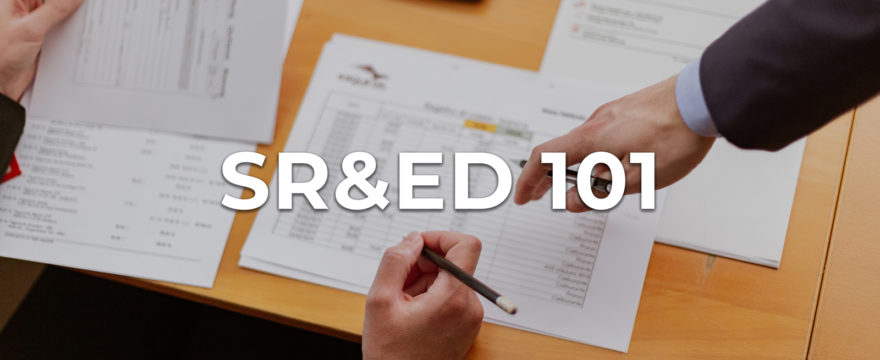
For companies participating in the Scientific Research and Experimental Development (SR&ED) tax incentive program, it’s important to understand which expenditures can be claimed. By knowing qualified SR&ED expenditures, companies can jumpstart their SR&ED documentation process and avoid delays.
SR&ED Program Eligibility
To claim SR&ED expenditures, businesses must meet the following program requirements:
- The work performed must address uncertainty and be approached with a systematic investigation involving the formulation and testing of hypotheses.
- The research has to be focused on science and technology. No other fields of interest apply.
Additionally, the SR&ED work must fall into one of three categories:
- Basic research – The process of advancing scientific knowledge for no other purpose than broadening our understanding.
- Applied research – The process of acquiring knowledge to answer specific questions and meet commercial objectives.
- Experimental development – The process of putting knowledge, experience, and insight toward achieving technological advancement for the purpose of creating or improving materials, devices, products, or processes.
Qualified SR&ED Expenditures
If all program requirements are met, businesses can proceed with claiming SR&ED expenses. Listed below are several types of qualifying expenditures.
Salaries and Wages
The SR&ED tax credit applies to salary and wages for personnel directly involved with the SR&ED project.
According to the Canada Revenue Agency (CRA), the types of activities that qualify for SR&ED expenditures, when directly supporting SR&ED projects, are the following:
- Data collection
- Mathematical analysis
- Computer programming
- Engineering
- Design
- Operations research
- Testing
- Psychological research
Materials
Businesses can claim expenditures for materials used during the commission of work. This can include the cost of supplier invoices, storage costs, and even necessary transportation costs.
Overhead Costs
Overhead refers to expenses that are not directly related to an SR&ED project but are necessary to support the business. One optimal example would be rent. Rent has no direct role in an SR&ED project, but the project would be unable to be completed without a facility.
Other overhead costs can include:
- Cleaning supplies
- Equipment
- General office furniture and equipment
- Utilities of an SR&ED facility, including electricity, heat, and water
- Maintenance and upkeep of the location and equipment
- Property taxes
Overhead expenses can be calculated and entered on the SR&ED claim form through either the traditional or proxy methods.
Traditional Method
In the traditional method of filing for SR&ED, the company must keep excellent records. The Canada Revenue Agency will ask claimants to identify and justify all SR&ED-related expenses. It’s vital to add overhead costs to the T661 form when employing this method.
Prescribed Proxy Method
The proxy method is the simplest method of claiming SR&ED expenses. Instead of keeping meticulous records of every single overhead expenditure, the company must determine the amount of salary that qualifies for the SR&ED tax credit. Overhead expenses will be a percentage of that total.
In addition to requiring less-detailed records, this method can also benefit most businesses as the estimated total is typically more than the actual sum. However, large companies or those making large claims may benefit more from the traditional method.
Try testing the proxy method using our SR&ED calculator.
SR&ED Contracts and Third-Party Payments
If a company has to pay a subcontractor to perform work related to SR&ED activities, the following expenses can be considered deductible:
Equipment
Businesses can claim equipment expenses, whether it is new, used, owned, or leased. The percentage of the cost eligible for a claim depends on whether it qualifies as all or substantially all (ASA) or shared-use equipment (SUE) equipment.
ASA applies to equipment meant to be used at least 90 percent of the time for SR&ED work. The tax incentive is based on the intended use and applies to its full cost.
SUE is intended mostly for the SR&ED work but can be used for other purposes. However, it must always be available for the SR&ED project. The tax credit is based on the equipment’s actual use and only applies to one-half of the cost or less.
Ineligible Expenditures
Any expense that is not in support of or related to the research and development project is not eligible for the SR&ED tax incentive.
Ineligible costs can include those related to:
- Sales and marketing
- Commercial production of a new or improved product
- Routine testing and maintenance
- Routine data collection
- Updates to a product’s style
- Research in social sciences or the humanities
- Prospecting, exploring, or drilling for minerals, petroleum, or natural gas
When Do Companies Typically Receive Their SR&ED Refund?
Once companies complete their SR&ED claim with eligible expenditures recorded, the general holding period for processing claims is 60 days. After the claim is accepted and selected for review, the Canada Revenue Agency can process the paperwork within 180 calendar days. This assumes there are no errors within the claim itself, and no additional support is needed by the companies to justify their expenses.
Receive Access To Your Funds Sooner
At Easly, we can help you access your SR&ED refund much sooner, eliminating the headache that comes with waiting. Our goal is to support Canada’s innovative companies by providing non-dilutive capital that suits their needs.
Discover more about our SR&ED financing options and how we can create a personalized solution for you, contact us today.
.png)
.png)
.png)
